LEGO Mindstorms sets are counted among the most widespread tools for teaching robotics and programming. The third generation of this set is presently available on the market in two versions: Education, for general school use, and Home, for individual consumers.
What are the differences between the two? Is the costly Education version better? Do programming apps differ as well? In this article, we try to answer all these questions and more.
To learn how to start teaching robotics with Mindstorms kits, sign up for the next webinar.
LEGO Mindstorms is a well-seasoned series of tools for learning robotics. The first set was revealed to the public in 1998 and very soon, it’ll have been already 20 years of education with LEGO Mindstorms. However, prototypes of the key element of every set – programmable brick – were being developed even earlier, in 1987. At that time, in MIT Media Lab, Seymour Papert was leading the team working on this very project. He also introduced constructivism into the world of education (learning by creating) and designed the very first educational programming language, Logo. As you can see, the overall success of the Mindstorms series is founded on many years of research and development.
Interestingly, the principle behind the sets never changed. Every Mindstorms set combines the popular LEGO Technic bricks, great for building miscellaneous mechanisms, with specially fitted electronic modules, such as motors, sensors and the microcontroller, also referred to as the control brick. Robots created with these elements can be programmed in a simple and kid-friendly programming environment.
Wide possibilities of the set and simple building system make it possible to conduct a full robotics lesson in a surprisingly short amount of time. Even 90 minutes suffice. This quality is absolutely unique among robotics sets available on the market. No wonder the series has a reputation for being one of the best tools for teaching robotics.
If you’re interested in a specific aspect of this set, jump straight to particular chapter: Building Elements, Electronics, Programming, or Educational Materials. For a quick read, go ahead to Conclusions. To read more about educational sets for the same age group, check out this article.
Despite confusingly similar names, LEGO Mindstorms EV3 Home (31313) and LEGO Mindstorms EV3 Education Core Set (45544) differ significantly. Disparities are present in every aspect. Starting with the box, through number and types of construction bricks, electronic elements (different sensors, remote), programming apps, and even materials accessible after purchase – none of them are identical. In truth, even availability of these sets varies. The Home version can be purchased in normal toy shops, whether online or not, but the LEGO Education version is sold only by official distributors.
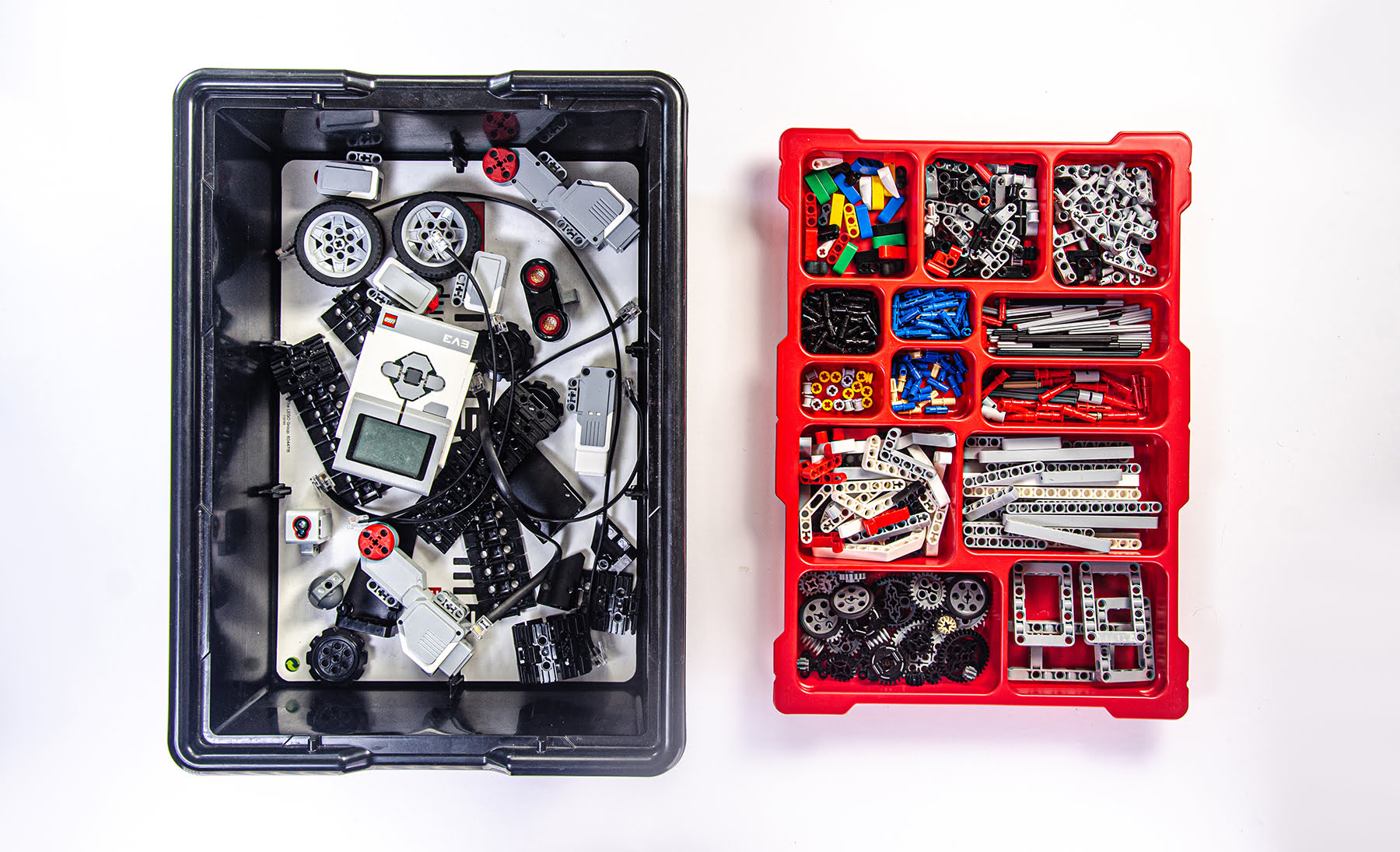
LEGO Mindstorms EV3 Education Core Set is contained in a handy, wide box made from durable plastic that ensures safe storage. The tray with 13 compartments allows you to easily sort bricks according to their size and purpose. Underneath, there’s space for keeping larger building elements, such as wheels, tracks, electronics and cables. Sorting makes it possible to build fast, with no need to spill bricks on the table, or on the floor. What’s more, the building process becomes less noisy, which will surely be appreciated by teachers using these sets on an everyday basis.
Inside the box, in addition to 541 elements, there’s a cardboard list of bricks that facilitates sorting the elements and a paper instruction on how to build a simple vehicle.
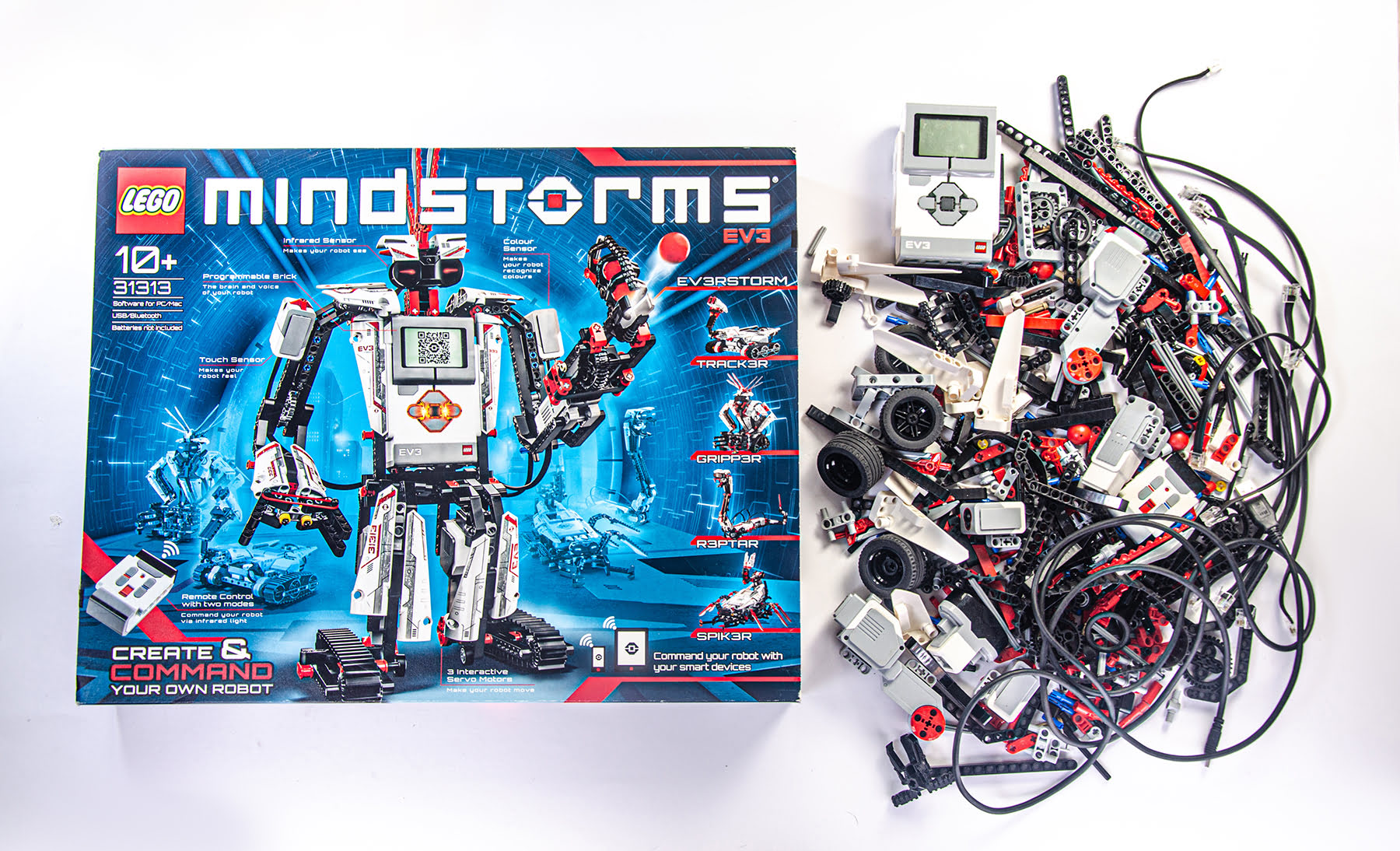
The version for home use is packaged similarly to the majority of classic LEGO sets – in a single-use cardboard box. The box has a fetching image on it, which definitely increases sales figures, but serves poorly as storage.
Although usually, you wouldn’t need a completely separate box to store a classic LEGO set (all bricks end up together), in this case, we’re dealing with a robotics set that contains unique electronic and building elements, so you should maintain it appropriately. If you buy the Home set version, you must also buy a container; in this regard, it matters little whether you plan to use the set at home, or at school. You can consider the original LEGO box, which is exactly the same as the one included in the Education version. Both the box and the tray can be purchased on the official LEGO Education website.
The container of the Home set is enclosed in a cardboard jacket. If you cut it along the line, you’ll find a simple testing mat on the reverse, helpful when working with the color sensor. In addition to electronics and construction elements, the set contains a sticker sheet to decorate several parts, and a paper instruction on how to build a robot.
BUILDING ELEMENTS¶
Both versions include a wide assemblage of Technic construction bricks. The differences lie in the amount, types and colors of these bricks.
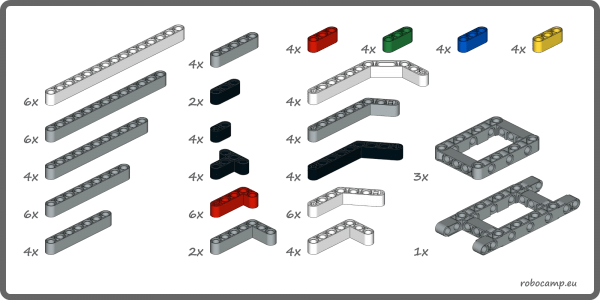
Let's start with the Education set. All 541 bricks of the Education set are dominated by white and gray, with sparse tinges of red, black and other colors.
Here, you’ll find straight Technic beams in 8 different lengths, 7 types of bent beams and two kinds of beam frames. Three studs long Technic beams are available in 5 base colors (red, green, blue, yellow, black), so you can surely use them for experimenting with the color sensor. The set also contains axles of 10 different lengths and 3 types of axles with end stop.
In order to connect axles with beams and frames, you can use 7 types of pins (which include smooth and friction pins for creating connections of varying strength), or one of 18 types of connectors, axle to pin ones included. For blocking, or separating bricks on an axle, you can choose from 2 types of bushings, or pin joiners (also known as tubes).
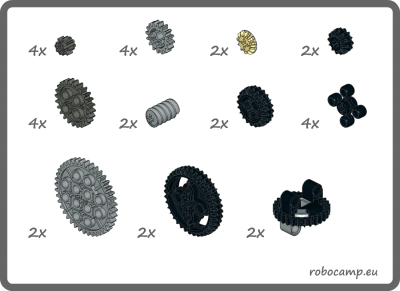
What’s more, you’ll find that the Education set has 10 different kinds of gears (normal and bevel ones) and two small turntables. In total, the Education set includes 30 elements for creating gear mechanisms, so you can design models with miscellaneous transmissions and ratio.
If you want to piece together a vehicle, you can use two large wheels with wide tires, smaller wedge belt wheels, or a steel ball placed in a plastic socket – a remarkably useful element. For example, it can serve as a great support wheel for two-wheel drive robots. The tracks included in the set are made of mulitple plastic track links joined together. Connect them with sprocket wheels and you’ll create a perfectly functional chain drive.
Vehicles with such a caterpillar drive advance well enough, but since the plastic surface is smooth, some gliding may occur. The easy solution is to purchase rubber attachments. Inserting them into holes of the track links noticeably increases traction. These attachments are available in the extension set produced by LEGO Education, purchased additionally. Nonetheless, you can always buy these elements separately.
This version of the EV3 set doesn’t contain many additional or decorative elements. The list of slightly less useful bricks is limited to 4 black panels for encasing completed constructions and 4 decorative “fangs”.
The Home version contains slightly more elements; 601 to be exact. The most visible change concerns colors. This set version is dominated by black bricks, with some red and grey ones. White elements, such as panels or blades, are purely decorative. Unfortunately, this color palette impedes the building process. It’s difficult to recognize particular parts in the black mass, so finding the one you need (remember there’s no sorting tray) takes more time. The black color also has a negative influence on legibility of building instructions.
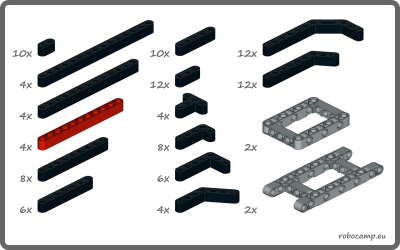
Putting aside the issue of ill-suited colors, the overall content of the set is similar to the Education version. It includes straight beams of 8 different lengths, 6 types of bent beams and 2 kinds of beam frames. In the Home version, however, short beams prevail. Long beams, useful for creating framework, are not as numerous. Moreover, there are no colorful bricks to use with the color sensor. Normal axles are available in 6 lengths only, but you have at your disposal 5 types of axles with stops.
For connecting them, the producer offers 6 kinds of pins and 21 types of connectors. The assortment of bushings and pin joiners is almost the same as in the Education version. Unique elements of this version include ball pins and links to match them, in two lengths.

Gears are available in 8 variations, which in total gives you 21 elements for creating gear mechanisms. Most of them are bevel gears. No turntables are included in this version.
To create vehicles, you may use four black tires with fitting rims. Caterpillar drive can be achieved by using rubber caterpillar tracks, which have good traction. Unfortunately, these tracks are quite fragile. If used often, they may stretch and stray from drive wheels.
The Home version is abundant in gadgets and decorations that, by definition, are not very practical. Consequently, you’ll come across 14 panels (for stickers), 10 decorative fangs in two colors, 4 decorative blades, and a ball shooter with magazine and 3 projectiles. The most striking example of vain elements is illustrated by 6 swords, which contribute to the warriorlike look of all constructions designed by LEGO. Still, it’s hard to use them for any other purpose.
All construction elements are very sturdy. LEGO is very particular about quality, so plastic parts are almost indestructible. Sometimes, pins may get damaged while dismantling the construction; children tend to “bite” them out, in spite of reminders. With intense use, teeth of the smallest gears can wear out. However, as a teacher, you should be more concerned that tiny elements of the set tend to get lost. Fortunately, LEGO offers a wide choice of spare parts, with which you can replenish your deficiencies.
For the Education version, LEGO prepared 8 different packs of spare parts. If you’re organizing a robotics workshop in school, you should buy one of every kind. This way, even if some parts do get lost, your workshop will be able to operate without any forced breaks. In case of the Home version, the producer didn’t prepare any dedicated spare parts packs. Nonetheless, you can always order individual parts for every LEGO set produced, no. 45544 included.
LEGO Education provides all kinds of expansions to the Mindsorms EV3 set. The most interesting one is a set of complementary parts called the Expansion Set. With 853 additional elements, the set significantly increases construction possibilities. Besides extra beams, axles and pins to increase the size of your constructions, the Expansion Set includes several interesting parts. Among others, it holds rubbers, new types of connectors, additional wheels and gears (differential), as well as the amazing big turntable, known from the Mindstorms NXT 1.0 set.
This expansion comes in a separate plastic box of the same size as the base set. Therefore, in order to efficiently work with the expansion, you’ll need to have sufficient working space to handle two large boxes. Once you finish classes, you’ll also need to separate elements accordingly. This expanstion is definitely a welcome addition. However, since it complicates logistics, it’s more suited for all-day workshops, or after-class robotics clubs, where time is not limited. If you must follow a strict timetable, think twice before you introduce this addition to your class.
BUILDING POSSIBILITIES¶
The building system in both versions is, of course, exactly the same. Since the system of LEGO Technic, where one connects beams with pins, is simple and well-known to the majority of children, the building process is trouble-free. Both set versions have wide possibilities in terms of construction, so students are able to swiftly test various solutions, which translates into boost to their creativity.
Despite significant differences in contents, the building possibilities are quite similar. But with the Education version, building is slightly more enjoyable. Why? Because you have access to unique parts: turntables, support wheel, or tracks made out of individual links. More cogwheels and beams allow to create mechanisms that are more efficient and more accurate; they also make the overall building process more productive. Purchasing the Extension Set further increases the advantage of the Education version in this category.
ELECTRONICS¶
Both set versions provide two large DC motors and a smaller one, as well as exactly the same microcontroller, known as the EV3 Brick. Differences become visible when you take a look at sensors.
Depending on the version you choose, you’ll get a different number and type of sensors; even the applied technology will differ. Motors and sensors can be connected with the brick by means of cables with plugs. Cables constitute the only element that wears out considerably soon, because plugs get damaged easily. You may think about stocking up – LEGO Education distributors can often help with that.
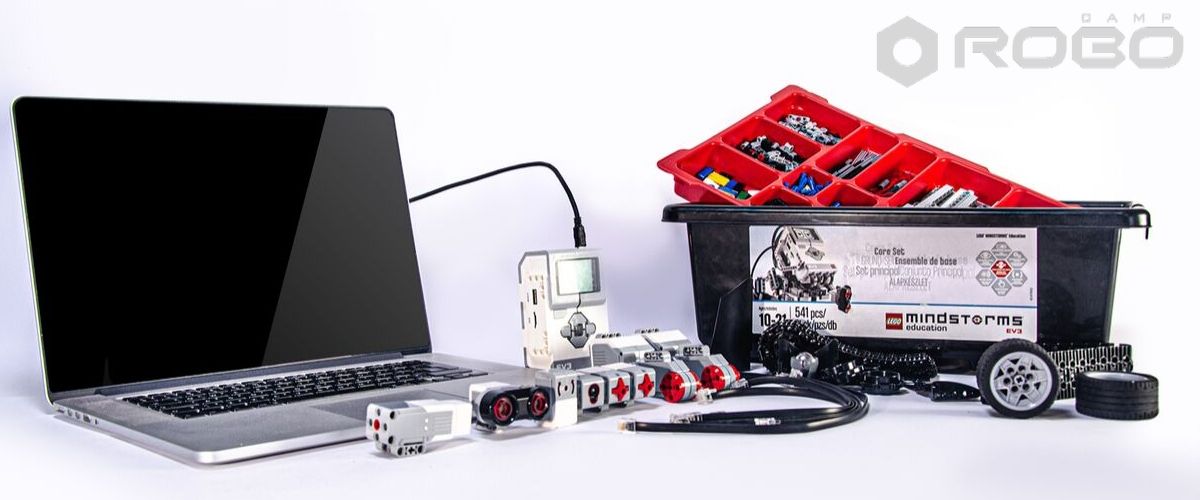
EV3 Brick¶
The main function of the EV3 Brick is to control created robots. The Brick is actually a microcontroller based on the ARM9 processor with Linux OS packed into one large LEGO brick. It’s equipped with display, speaker, 6 buttons (5 programmable ones, highlight included), 4 input ports, 4 output ports, mini USB port for computer connection, USB port, Micro SD port (up to 32 GB) and battery case. Communication with the device is possible via USB cable, built-in Bluetooth module, or WiFi (if you plug the external WiFi module into the USB port of the Brick).
In use, the Brick performs decently. However, its menu is not exactly user-friendly and start-up takes a bit of time (around 30 seconds), which may be irritating for some. From time to time errors do occur; the Brick may crash or turn off on its own accord. In such cases, it usually helps to update the firmware, or reset the Brick. If you’re having other problems with the Brick, this article might help you.
Every EV3 Brick can be powered with 6 AA batteries. You can also power it with a dedicated LEGO DC battery. It’s included in the Education set, but in order to use it, you must separately buy a costly charger. Before you do, note that the LEGO battery enlarges the EV3 Brick, so it cannot be used in all robot models. Moreover, relying on it is not the best choice due to time limits. Charging it takes a lot of time, during which you clearly can’t use the set. You may decide to purchase DC batteries in a two-pack, but in truth, it’s not really cost-effective (around 90$ for one battery and 40$ for charger).
Instead, we recommend equipping your workshop with a doubled stockpile of good-quality rechargeable AA batteries and several effective chargers.
Motors¶
In both versions of the EV3 set, you’ll find two large and one medium DC motors. All motors have a built-in rotation sensor. One of its possible uses is to coordinate two motors present in one construction, so that the robot advances straight forward. Sensor readouts can also be used in programming exercises, i.e. as control levers. Rotation control in both types of motors is very precise (up to 1°), thanks to the built-in tachometer.
Large motors have higher power and a big rotating head, which facilitates drive transmission. They reach 170 rpm. The smaller motor is capable of higher speed (up to 250 rpm) at the expense of the power available. Thanks to its size, it can be easily incorporated into numerous constructions.
Touch sensor¶
Touch sensor is included in both versions of the set. It’s a simple analog sensor, which detects whether the button is being pressed, or not. You can use it to run or stop operation of a construction, to create bumpers, or to count button presses. Together with 5 buttons on the EV3 Brick (they are touch sensors as well!), you may even create an advanced system to control your robot.
Color sensor¶
This sensor is included in the Home and Education version of the LEGO Mindstorms EV3 set. It collects data concerning colors (distinguishes 8), or light intensity (ambient, or of a reflected beam). It can be useful in line followers, sumo fights, or sorting devices.
Gyro sensor¶
The gyro sensor is available only in the Education version. Composed of several accelerometers, this sensor measures angular position and can detect changes in the position of an object with the accuracy of 3° in all axis of rotation. It can prove especially helpful when creating balancing robots, or controllers reacting to changes in tilt.
Distance sensor¶
Depending on the set version, a different technology is used to measure distance.
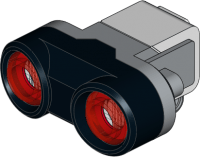
The Education set includes an ultrasound sensor. It produces ultrasonic waves, which upon encountering an obstacle rebound and return to the sensor. The time elapsed between sending and retrieving of the signal is used to estimate distance from the obstacle. The measurement is quite precise (+/- 1 cm); the measuring range covers 1 to 250 cm. In addition to distance, the sensor can produce ultrasounds and detect ultrasounds in its environment. Thus, this element can be used to measure distance, pass through labyrinths, or detect objects.
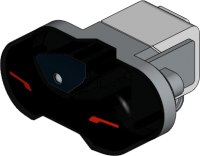
The sensor of the Home version relies on the infrared technology. It’s capable of detecting obstacles up to 50 – 70 cm. Unfortunately, the measurement is not precise. The distance is expressed in units of somewhat vague definition and is often misleading. Consequently, measurement errors are frequent. Due to the technology applied, even color of an object influences the measurement. Because the measurement uncertainty is so significant, LEGO claims the sensor doesn’t measure distance, but “proximity”. However, the real function of this IR sensor is not to measure anything, but rather to receive signals from the remote, which also uses IR technology to communicate.
Remote¶
The IR remote is included only in the Home version of the set. You can use it with the IR sensor to create an infrared radiation transmitter; your robot will be able to detect produced signals as far as 2 m away. Most often, however, this device is used to remotely control the robot. For this end, you have 5 programmable buttons at your disposal (and their combinations, so 11 programmable actions in total). There are 4 channels available for communicating with the IR sensor, so in order to avoid any interference, you shouldn’t actively use more than 4 sets within a radius of 2 m. The remote is powered by two AAA batteries.
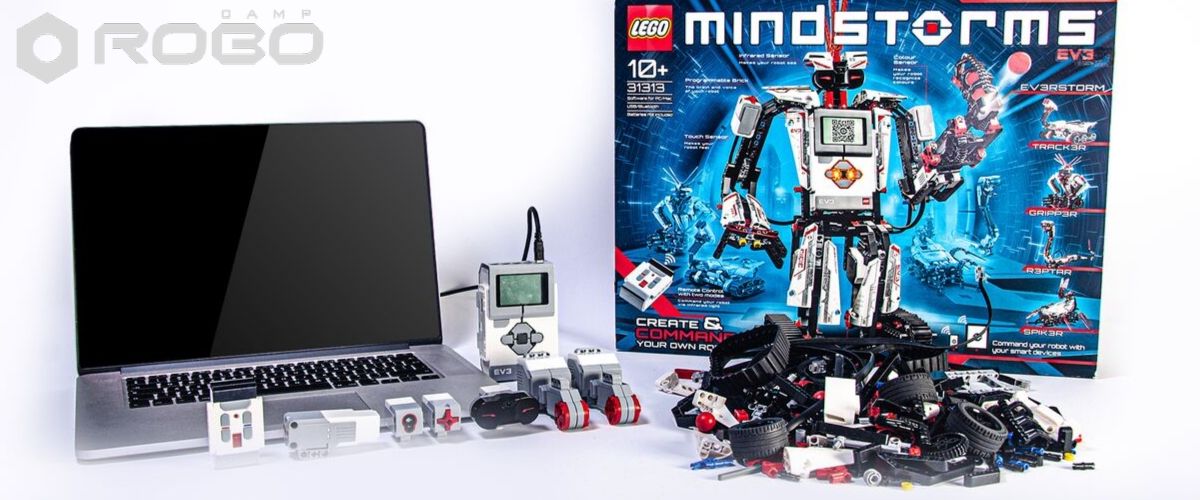
All electronic elements are good quality. The very first problems appear only after a few years of intense use.
Purchasing additional cables (they break down first) and individual electronic modules is definitely worth considering. By doing this, you can even enhance the Home set version, which has some lacks in the original content. In addition to the sensors described above, LEGO Education prepared a temperature sensor for the EV3 set. Other producers have even more sensors in their offer and they are definitely worth checking out. For example, HiTechnic sensors are commendable; they sell compatible compasses, magnetic field sensors, and many others.
PROGRAMMING¶
LEGO Mindstorms EV3 sets can be programmed through the dedicated app, based on LabView. You can access it on computers and tablets. You should be aware that depending on what set version you have and what device you use, the app content will differ. Therefore, in total, there are 4 different programming environments for the EV3 set.
The EV3 software allows to program robots in an intuitive graphic language. Programs are created by dragging individual instructions to the start block. Once completed, the program must be uploaded to the EV3 Brick. When you activate it, the commands included in the program will be executed from left to right. Every instruction block can be adjusted through various options.
Overall, the environment is good for controlling LEGO robots in a simple and precise manner. Programs are created easily, almost intuitively, and all block options are visible right away. The only problem concerns the size of the blocks. Longer, more complex programs don’t fit on the screen, which forces users to scroll the preview. This flaw makes the process of creating advanced programs slightly inconvenient. However, it’s rarely a problem for projects executed during school robotics classes.
At a later stage of education, it’s possible to introduce text programming of the EV3 robots. The language selection is quite wide. You can choose from the dedicated languages: EV3Basic and Robot-C, or even take up one of the classics, e.g. Java or Python (after you install a new OS on the EV3 Brick – more on ev3dev.org).
The EV3 Brick connects with the computer, or tablet, by using Bluetooth technology, WiFi (if you attach the external WiFi module), or USB cable. The last method is perhaps plain, but trouble-free. Once you upload a program to the Brick, you can disconnect the USB cable and the robot will operate autonomously.
COMPUTERS¶
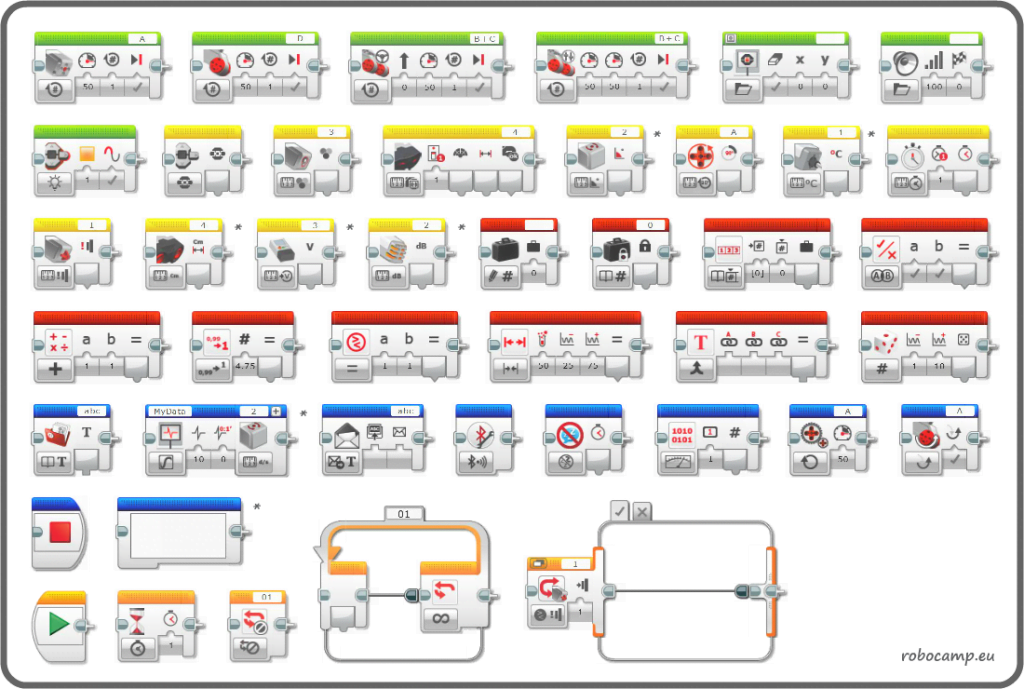
Programming the EV3 sets on a computer provides the most possibilities and enables you to fully exploit their potential. Both in the Education and the Home versions, you get access to a full palette of programming blocks, which are grouped into 6 categories. You’ll be able to browse action blocks (controlling motors, display and highlight of the Brick buttons), flow control blocks (waiting, conditions, loops), sensors blocks, data operations blocks (variables, lists, mathematic operations), advanced blocks and finally, blocks created by the user.
The Education and Home versions differ in appearance and materials available. The Education app, in addition to the programming environment itself, gives you access to building and programming instructions for models created from the Education set, to introductory teaching materials about the world of LEGO Mindstorms robotics, and to tools for documenting projects and registering data, which are especially useful during experiments.
The Home app doesn’t include additional features. It comes with the programming environment, building and programming instructions for several #31313 set robots, and a tool for documenting your projects. It also includes several short introductory videos and a link to user guide. The blocks palette of the Home version was slightly reduced in comparison to the Education one.
The Education app works on computers with Windows (7, 8 and 10), or with Mac OS in version 10.6 or newer. You can download the app here.
The Home app is compatible with Windows Vista OS or newer, and with Mac OS in version 10.6 or newer. You can download the app here.
TABLETS¶
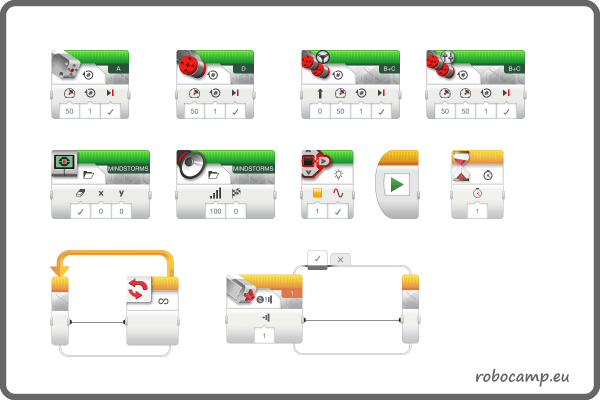
The Mindstorms EV3 series has separate apps for programming on tablets. Their possibilities are considerably limited, simply because they have fewer blocks. You have access to only 3 palettes out of 6 available on the computer version. You won’t find any data, or advanced blocks, and you certainly won’t be able to create any blocks of your own. The tablet app version allows you to create only the most basic programs, which potentially restricts the knowledge one could gain.
The Education app is available for tablets with iOS (8.0 or newer), with Android 4.2 or newer, as well as for Chromebooks, Kindle Fire tablets, and touch screen devices with Windows 10 OS. For more information, go to Google Play, App Store, or to the LEGO Education website.
The Home app can be downloaded through Google Play and App Store. It’s compatible with iPad 2.0 or its newer version, as well as with iOS 8.0 (or newer). For Android devices, no specific requirements were defined.
EDUCATIONAL MATERIALS¶
EDUCATION SET (45544)¶
To start your learning adventure with LEGO Mindstorms EV3 Education, go to the Quick Start tab. It contains several instructional videos that guide you through the possibilities of the app. In the menu, you can also find building instructions of sample models, robotics tutorial and supporting material.
The software comes with access to building instructions of 10 (in truth, it’s 11) robots. Unfortunately, 6 of them require elements from the Expansion Set: Tank Bot, Znap, Stair Climber, Elephant, Spinner Factory and even Remote Control, which can be used to control other robots (on the condition that you have at least two EV3 sets). Only 4 robots can be built by using the Core Set alone: Gyro Boy, Color Sorter, Puppy and Robot Arm H25.
All models are interesting, but also complicated to build and program, so the entire process of assembling them, creating their programs and testing takes a lot of time. In consequence, it’s difficult to use these designs during robotics classes. Note that instructions do not cover step-by-step programming. As soon as you complete building the robot, you get an already finished, complicated program, which may be hard to understand at first glance. Unfortunately, immediate access to a completed program impairs the educational value of the project; students don’t get the chance to create the program from scratch, they don’t test it, or correct programming mistakes.
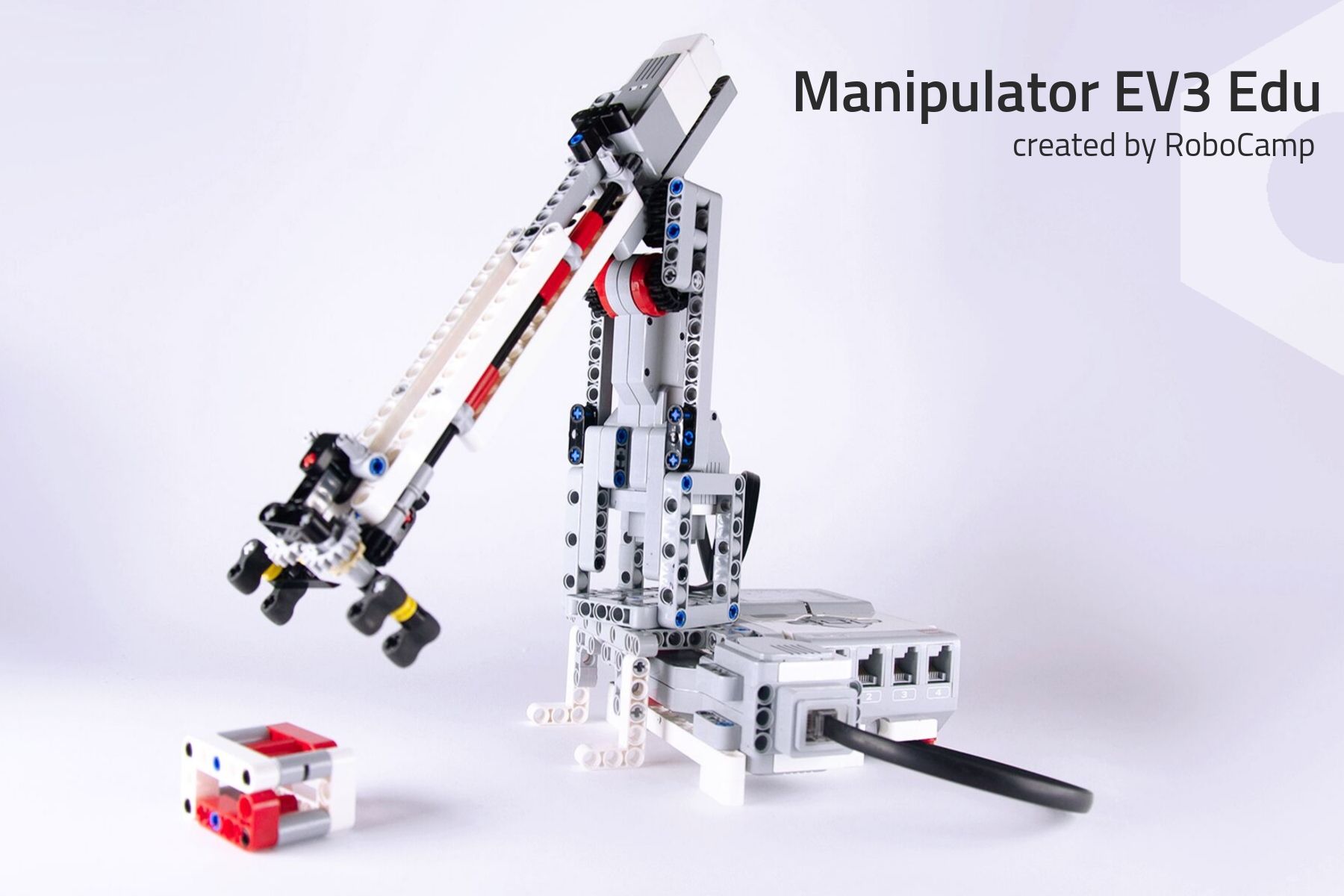
Fortunately, another part of the app contains a highly valuable tutorial named Robot educator. Here, you’ll find the most interesting material in terms of educational use. It shows and explains capacities of electronic elements, of basic and advanced programming blocks, as well as functions of software tools, with which you can register and present the data received from sensors.
Moreover, the tutorial hides away the most useful construction: the simple Driving Base, which we count as the 11th robot! Its instructions also cover some accessories; among others, you can attach one more motor and a frame for catching objects, a touch sensor, a color sensor (positioned downward or forward), a distance sensor, and a gyro sensor. Together with programming instructions available in the programming tutorial, this straightforward construction can become a base for many fascinating lessons.
Building instructions created by LEGO are of good-quality, but lack the before and after preview. Because of it, whenever you’re reading steps that depict large parts of the construction, you might feel as though you’re playing “Where’s Waldo?” It’s surprising that LEGO still hasn’t included this feature in their instructions. After all, it’s not a complicated piece of software, yet it’s immensely helpful (which is why it’s in RoboCamp instructions).
The described material is available in the app version for PC. Tablet version users have a very limited choice. The tablet app contains only the Robot Educator tutorial, but not in its entirety.
HOME SET (31313)¶
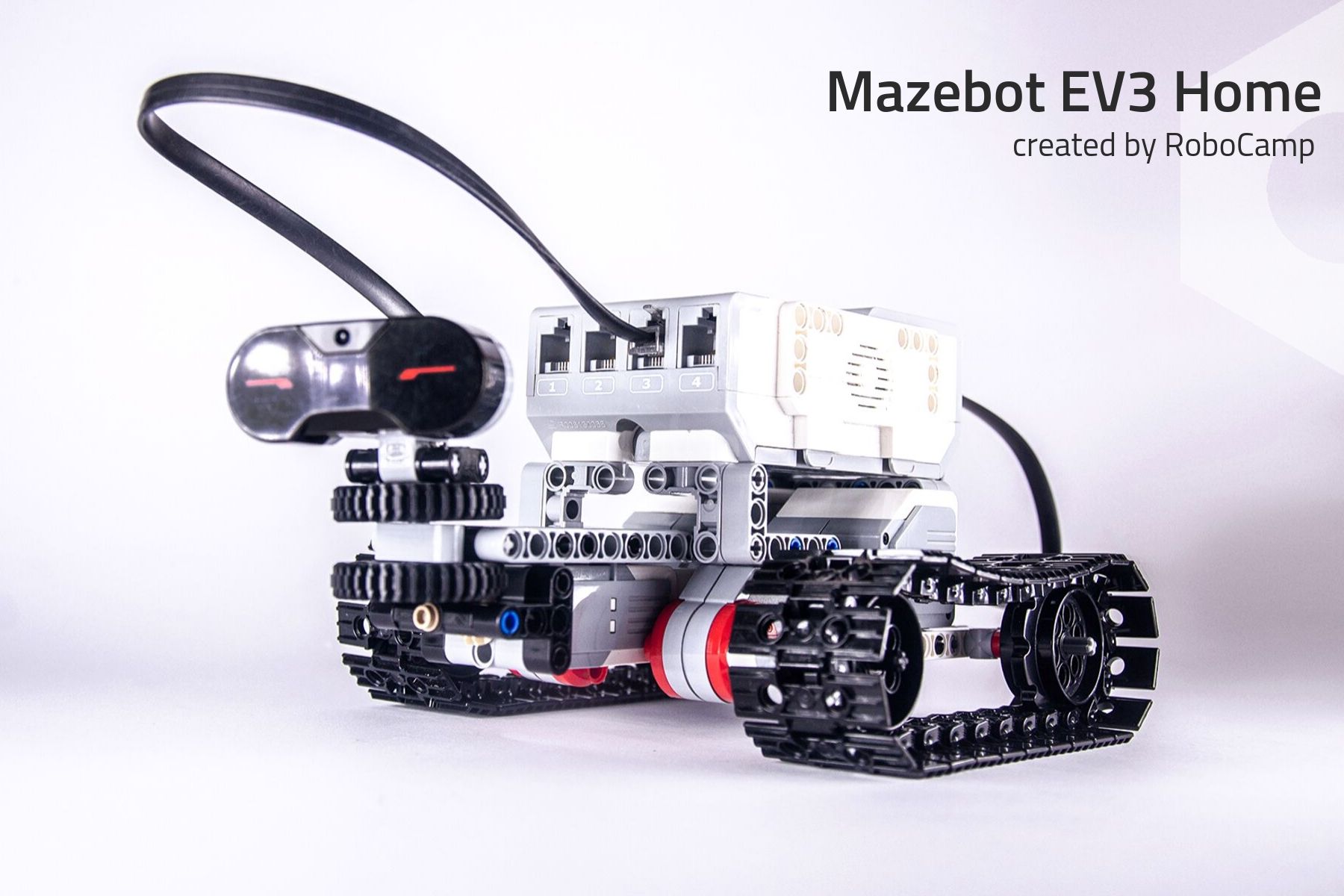
The Home version of the software for LEGO Mindstorms EV3 set includes a completely different selection of materials. Upon running the software, you enter a loud lobby, where you can select one of five warriorlike robots: EV3STORM the humanoid shooter, R3PTAR the cobra model, GRIPP3R the grasping device, TRACK3R the tank with exchangeable tools, and SPIK3R the scorpion. The app also allows you to download 12 additional models created by the LEGO Mindstorms community.
In addition to the building instructions, this app version also comes with detailed step-by-step programming instructions. They allow users to create and test programs on their own. However, they are available only for the five original LEGO constructions. In other projects, the advanced programs are presented already complete with commentaries only.
Similarly to the Education version, the robots designed by LEGO are complicated in terms of building and programming. Again, completing them takes time, which hinders potential class use. In addition to robot projects, the materials contain several short instructional videos on possibilities of the environment and link to user guide.
In the tablet version, the app looks quite similar. You get access to building instructions of the 5 LEGO robots (without programming instructions) and 12 projects created by the LEGO community. Nonetheless, many projects submitted by the community include information that full possibilities of a given model can be discovered only by using the full software version, the one available on PC.
COST¶
- LEGO Mindstorms EV3 Education Core Set (45544): $411.95
- LEGO Mindstorms EV3 Home Edition (31313): $349.99
- LEGO Mindstorms Education EV3 Expansion Set: $103.95
CONCLUSIONS¶
LEGO Mindstorms EV3 sets have many assets and stand out among competitors, regardless of the version. The building system is easy and quick, the elements are durable. Since the entire set is founded on LEGO bricks, all constructions can be assembled in a nice, easy way and most importantly, very swiftly. Construction and electronic elements are diversified, which equips teachers with basis for earnest teaching of elementary mechanics and physics. These sets also develop creativity, because they encourage testing out individual ideas.
Undeniably, they have wide possibilities and can be used even on higher levels of education. Many colleges and universities decided to adopt the EV3 into their robotics and mechatronics labs. The software for programming robots (especially in the PC version) is a great tool for learning basics of programming. It allows users to create advanced programs easily, in an intuitive manner, which fosters computational thinking and helps beginners to understand basic concepts without any need for learning complicated syntax of text programming languages.
Comparison between LEGO sets and other robotics sets currently available on the market can be found here.
The differences between the two versions available on the market seem small at first glance, but concern the parts most essential to teaching. LEGO Mindstorms EV3 Education Core (#45544) is the set created for learning. It’s visible in almost every aspect. This version has a useful box that facilitates storing and quickens building thanks to the sorting tray; the construction elements are better thought-out; the sensors are more interesting; the programming app provides more options; the robot models constitute a better base for learning.
All these factors have a positive influence on the lesson flow and enable teachers to conduct a full robotics lesson (introduction, building, programming and testing) even in 90 minutes. The only problem might be finding materials for lessons fitting this time framework; the Robot educator tutorial doesn’t suffice for long. One solution is to prepare such a curriculum on your own, another is to use solutions prepared by professionals (e.g. RoboCamp courses).
LEGO Mindstorms EV3 Home (#31313), the version created for individual users, is less practical. Consider the cardboard box, the red and black colors that hamper finding right elements, even the content of the set (6 swords!) – everything in this version is influenced by the marketing strategy. The IR distance sensor is weaker than the one in the Education version. It’s less precise than the ultrasonic one, but in exchange, you can use the remote to control robots.
The programming software for the Home version is very similar. The most significant aspect, coding, is carried out exactly the same way, but there are less programming blocks to use. This version has neither tools for collecting and presenting data, nor any material for the teacher.
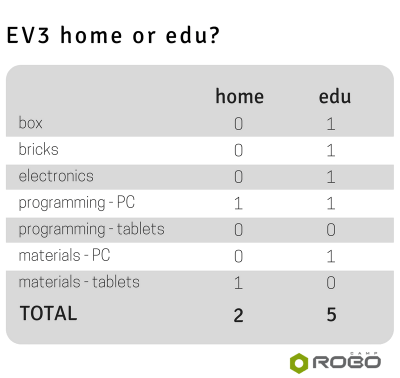
The table summarizes our evaluation of both sets. If one version has advantage over the other in a given category, it gains a point. If both versions are comparable in a given category, they both receive a point. In such a simplified summarization, the Education version wins in almost every category. However, it’s worth noting that these differences are also reflected in adequate prices of respective versions.
Teaching in class with the Home set is doable. But it’s important to compensate for any deficiencies of this version, i.e. purchasing appropriate storage box and educational materials. Later on, you may also consider buying more sensors (ultrasonic distance sensor and gyro sensor), which are not accounted for in this set.
Additional educational material is helpful with both versions. All projects prepared by LEGO (except for the Robot educator exercises) are very complex. By consequence, they take too much time to be efficiently applied during normal school classes. It concerns both construction and programming. For strictly school environment, we recommend CityCAMP EV3 (for Home and Education versions) and DiscoveryCAMP EV3 (for Education version). Every lesson included in these themed series can be completed in 90 minutes. Sample exercises are available for free in our demo course.



